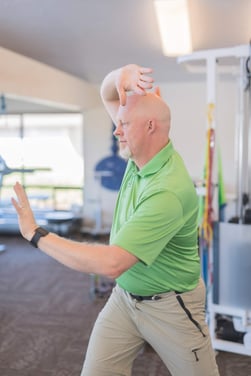 Think about the last time you took a walk and really noticed how your body felt. Were you light on your feet, or did you feel like you were leaning forward or shuffling a bit? How we hold and move our bodies affects how steady, strong, and comfortable we feel.
Think about the last time you took a walk and really noticed how your body felt. Were you light on your feet, or did you feel like you were leaning forward or shuffling a bit? How we hold and move our bodies affects how steady, strong, and comfortable we feel.
“Walking tall” is not about looking a certain way, its about supporting your body so movement feels natural and secure. Three things help with that: confidence, a supportive core, and gentle cardiovascular activity like walking.
Confidence Begins with Awareness
Confidence in movement starts with simply paying attention to how your body is aligned. Imagine creating space between your ribs and hips, softening your shoulders, and letting your gaze rise. This position helps you move more freely and take steadier steps. It also allows for easier breathing and more efficient movement.
Your Core Helps You Stay Steady
The core includes the muscles of the abdomen, hips, lower back, and pelvis. These muscles work together to keep you steady while you sit, stand, and move. A supported core helps with balance, reduces stress on your back, and makes everyday tasks feel easier.
Here are a few gentle core activities you can try:
- Seated Posture Hold
Sit near the front of a chair. Keep your feet flat on the floor. Lengthen your spine and gently draw your lower belly inward. Hold while breathing for 10 seconds. Repeat 5 to 8 times. - Slow Standing March
Stand with support from a counter or sturdy chair. Slowly lift one knee, set it down, then lift the other. Move with slow control. Perform 10 to 20 marches. - Weight Shift Exercise
Stand upright with both feet under your hips. Gradually shift your weight to one foot while keeping your posture tall. Then shift back to center and to the other foot. This helps train balance and core coordination.
Cardio Supports Energy and Ease
Walking is one of the most supportive activities for healthy aging. You do not need to walk fast or for long periods. A few short, comfortable walks each day can support heart health, boost mood, and help maintain independence. Focus on an easy pace and smooth, steady steps.
Bringing It All Together
Standing tall, using your core, and moving consistently throughout the day can help you feel more balanced and confident. Small changes practiced regularly add up. Begin with one moment of awareness at a time, and let that confidence grow with every step.

 We all want to stay strong and active as we age, but real strength isn’t just about how much weight you can lift or how far you can walk—it’s about how you carry yourself. Good posture is like a superpower. It helps you move with confidence, reduces pain, and gives you more energy throughout the day. When we stand tall, everything from balance to breathing improves.
We all want to stay strong and active as we age, but real strength isn’t just about how much weight you can lift or how far you can walk—it’s about how you carry yourself. Good posture is like a superpower. It helps you move with confidence, reduces pain, and gives you more energy throughout the day. When we stand tall, everything from balance to breathing improves. It’s not uncommon for people to describe uncomfortable physical sensations; musculoskeletal discomfort has become increasingly common. If you think about the average office worker, they will likely talk about pain in the neck, upper traps, and shoulders. Why these specific areas? When people are stressed, they have a tendency to hunch over and round the upper back. This tightens the aforementioned muscles, causing irritation. Trauma and chronic stress can have a lingering impact on our bodies; the body can unconsciously tense up, causing chronic pain.
It’s not uncommon for people to describe uncomfortable physical sensations; musculoskeletal discomfort has become increasingly common. If you think about the average office worker, they will likely talk about pain in the neck, upper traps, and shoulders. Why these specific areas? When people are stressed, they have a tendency to hunch over and round the upper back. This tightens the aforementioned muscles, causing irritation. Trauma and chronic stress can have a lingering impact on our bodies; the body can unconsciously tense up, causing chronic pain. 
.jpg?width=389&name=GettyImages-974640830%20(1).jpg) Many of us suddenly have been thrust into working from home. I am sitting on a folding chair, leaning over my keyboard, looking at my laptop screen that is sitting on a folding table. Needless to say, I am not in an ergonomically sound position. The Mayo Clinic has a great blog about
Many of us suddenly have been thrust into working from home. I am sitting on a folding chair, leaning over my keyboard, looking at my laptop screen that is sitting on a folding table. Needless to say, I am not in an ergonomically sound position. The Mayo Clinic has a great blog about  You might have heard that yoga is great for flexibility and a great opportunity to meditate. Beyond those benefits,
You might have heard that yoga is great for flexibility and a great opportunity to meditate. Beyond those benefits, 

 Good posture
Good posture